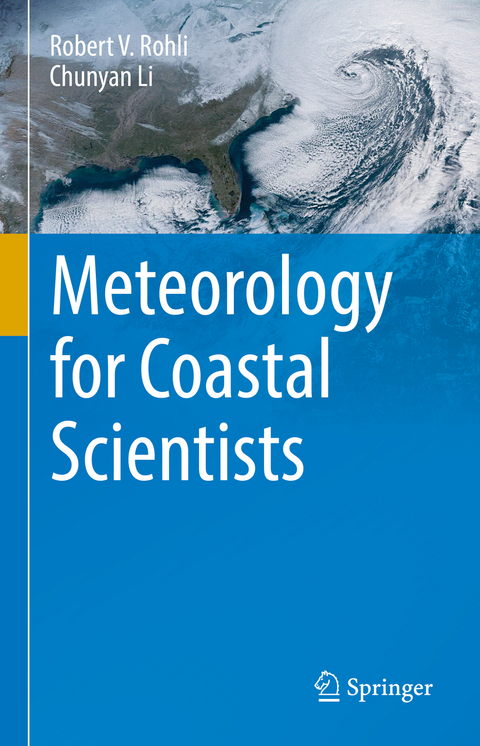
Meteorology for Coastal Scientists
Springer International Publishing (Verlag)
978-3-030-73092-5 (ISBN)
This is a textbook for non-atmospheric specialists who work in the coastal zone. Its purpose will be to help coastal environmental, engineering, and planning professionals to understand coastal atmospheric processes. This in turn will allow more effective communication with climate modelers, atmospheric environmental consultants, and members of the media.
The coastal environment is among the most intensively used and chronically abused components of the Earth-ocean-atmosphere system. It is also home to an ever-increasing proportion of humanity with their increasing development, trade, transportation, and industrial activities, amid increasing impacts of natural hazards. The atmosphere is an integral part of the system, with all of the above human activities affecting and being affected by atmospheric processes and hazards. Yet few of the specialists studying the coastal environment have expertise on atmospheric processes, this therefore presents a highly relevant textbookon coastal atmospheric processes.
Dr. Robert V. Rohli is an atmospheric scientist with a B.A. in geography from the University of New Orleans, an M.S. in atmospheric sciences from The Ohio State University, and a Ph.D. in geography from Louisiana State University. His research involves atmospheric circulation variability, tropical cyclone dynamics, natural hazards, and applied meteorology/climatology.
Dr. Chunyan Li is a physical oceanographer with a B.A. in atmospheric physics from University of Science and Technology of China, an M.S. in physical oceanography from Chinese Academy of Science, and a Ph.D. in oceanography from University of Connecticut. His coastal and estuarine dynamics research includes impacts of hurricane storm surge and fronts/extratropical cyclones.
Part I. Introduction to Our Coastal Atmosphere.- Chapter 1. The Scope and Uniqueness of Our Coastal Atmosphere.- Chapter 2. Atmospheric Composition, Structure, and Evolution.- Part II. Thermodynamics in Our Coastal Atmosphere.- Chapter 3. Energy Transfer / Electromagnetic Radiation.- Chapter 4. Temperature.- Chapter 5. Application of the Gas Laws in Meteorology.- Chapter 6. The Hydrostatic Equation and Adiabatic Processes.- Chapter 7. Atmospheric Moisture.- Chapter 8. Atmospheric Stability and Potential Temperature.- Chapter 9. Measuring and Estimating Atmospheric Stability.- Chapter 10. Using Thermodynamic Diagrams in Meteorology.- Chapter 11. Clouds.- Chapter 12. Precipitation Processes and Types.- Part III. Dynamic Processes in Our Coastal Atmosphere.- Chapter 13. Pressure and Winds.- Chapter 14. Coriolis Effect.- Chapter 15. Effect of Friction.- Chapter 16. The Gradient Wind.- Chapter 17. Gravitation.- Chapter 18. The Seven Basic Equations in Weather Forecasting Models.- Chapter 19. Comparison of Weather Forecasting Models and GCMs.- Chapter 20. General Circulation of the Atmosphere.- Part IV. Weather Systems in Our Coastal Zone.- Chapter 21. Air Masses.- Chapter 22. Atmospheric Lifting Mechanisms.- Chapter 23. Fronts and the Mid-latitude Wave Cyclone.- Chapter 24. Thunderstorms.- Chapter 25. Lightning.- Chapter 26. Tornadoes and Waterspouts.- Chapter 27. Advising the Public about the Severe Weather Risk.- Chapter 28. Tropical Cyclones.- Chapter 29. Coastal Flooding.- Chapter 30. Coastal Drought.- Chapter 31. Winter Storms.- Chapter 32. Sea Ice and Weather Systems.- Chapter 33. Summary of Energy Transfer by Atmospheric Motion.- Part V. Atmospheric Boundary Layers and Air-Sea Interaction.- Chapter 34. Introduction to the Near-surface Atmosphere.- Chapter 35. The Logarithmic Wind Profile in Neutral Stability Conditions.- Chapter 36. The Non-neutral or Diabatic Wind Profile.- Chapter 37. Introduction to the Transition (or Ekman) Layer.- Chapter 38. The Classical Solution to the Atmospheric Ekman Spiral.- Chapter 39. The Modified Ekman Spiral Solution in the Atmosphere.- Chapter 40. Fundamentals of Air-Sea Interactions.- Chapter 41. Weather Effects on the Ocean.- Chapter 42. Wind Stress and Turbulent Flux Drag Coefficients over Water Surfaces.- Part VI. Air-Sea-Land Interaction.- Chapter 43. Surface Fluxes of Energy, Moisture, and Momentum.- Chapter 44. Sea and Land Breezes.- Chapter 45. Coastal Fog.- Chapter 46. Coastal Upwelling and Weather.- Chapter 47. Atmospheric Impacts on Lake Processes.- Chapter 48. Coastal Jets.- Chapter 49. Atmospheric Optical Effects in Our Coastal Zone.- Part VII. Planning and Engineering Applications.- Chapter 50. Atmospheric Dispersion in Our Coastal Zone.- Chapter 51. Meteorology and Climatology of Coastal Cities.- Chapter 52. Engineering Aspects of the Wind Profile.- Appendix A. Système International Units Commonly Used in Meteorology.- Appendix B. "Retired" Atlantic-Caribbean-Gulf of Mexico Hurricane Names.- Index.
| Erscheinungsdatum | 19.10.2021 |
|---|---|
| Zusatzinfo | XIII, 525 p. 340 illus., 252 illus. in color. |
| Verlagsort | Cham |
| Sprache | englisch |
| Maße | 155 x 235 mm |
| Gewicht | 1049 g |
| Themenwelt | Naturwissenschaften ► Biologie ► Ökologie / Naturschutz |
| Naturwissenschaften ► Geowissenschaften ► Geologie | |
| Naturwissenschaften ► Geowissenschaften ► Hydrologie / Ozeanografie | |
| Naturwissenschaften ► Geowissenschaften ► Meteorologie / Klimatologie | |
| Schlagworte | air-sea interaction • Air-Sea-Land Interaction • Atmospheric boundary layer • atmospheric dynamics • Atmospheric Thermodynamics • Coastal Meteorology • Coastal Natural Hazards • Coastal Weather • Coastal Weather Systems • Coastal Zone Management • meteorology |
| ISBN-10 | 3-030-73092-1 / 3030730921 |
| ISBN-13 | 978-3-030-73092-5 / 9783030730925 |
| Zustand | Neuware |
| Haben Sie eine Frage zum Produkt? |
aus dem Bereich


